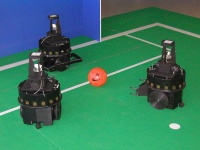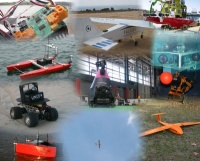PCMMC: Perception-Driven Coordinated Multi-Robot Motion Control: Difference between revisions
No edit summary |
No edit summary |
||
| Line 1: | Line 1: | ||
[[Image:LogoIST.jpg|50px]] [[Image:Logo-feup.gif|150px]] [[Image:Logo_ISEP.jpg|150px]] | [[Image:LogoIST.jpg|50px|center]] [[Image:Logo-feup.gif|150px|center]] [[Image:Logo_ISEP.jpg|150px|center]] | ||
==Abstract== | ==Abstract== | ||
[[Image:Soccer.jpg|left|200px]] | [[Image:Soccer.jpg|left|200px]] | ||
Revision as of 14:12, 4 May 2010



Abstract

Several robotic tasks require or benefit from the cooperation of multiple robots: transportation of large-size objects, large area coverage (e.g., for cleaning) or surveillance (e.g., for fire detection), pollutant plume tracking, or target detection and tracking, to name but a few.
In this project, we propose a novel active approach to cooperative perception through coordinated vehicle motion control. The vehicle formation geometry will change dynamically so as to optimize the accuracy of cooperative perception of a static or dynamic target by the formation vehicles. To achieve this, we will introduce innovative decentralized low-communication formation full state estimation methods, and dynamic-goal-driven formation control, for cooperative target localization and tracking by decentralized fusion of the data measured by all the formation vehicles.
We will also develop a novel embedded framework prototype to implement our contributions with low computational and power requirements, and test the proposed solutions in real robot scenarios, namely
- heterogeneous outdoor (aerial + land) vehicle formations, for extended decentralized perimeter surveillance and intruder tracking/event detection, in hostile environments with limited-range terrestrial communications (border control, forest fire detection or search and rescue operations);
- heterogeneous (non-holonomic and omnidirectional kinematics, different vision systems) soccer robots with a common target (tracking a ball), in a highly dynamic and adversarial environment, often subject to occlusions and “kidnappings”.

Real scenarios mean real wireless communications, plagued with link failures and limited bandwidth, and perception noise, often non-Gaussian, and subject to non-linear measurement and motion dynamic. Real robots and moving targets imply real-time requirements as well. We will also investigate methods that cope with all such constraints, namely reduced-dimension data representations (e.g., Gaussian Mixture Models), particle filter sampling of probability density functions, embedded frameworks that take into account power, communications and computational requirements, communications middleware to provide efficient use of the available resources, interoperability, heterogeneity abstractions, automatic re-configuration, and real-time communication protocols. Altogether we will explore simultaneously the complementary directions of coping with noisy perceptions and non-linear dynamics, as typically followed by the networked control community, while improving the communications quality and system lifetime, typically addressed by the real-time communications community, maximizing the improvement in the global system performance.
Resumo / Controlo Coordenado do Movimento de Multi-Robots Baseado na Percepção
News and Media
Workshop at Universidad Carlos III de Madrid
Partners
- Instituto Superior Técnico / Instituto de Sistemas e Robótica (IST/ISR - leader)
- Instituto de Engenharia de Sistemas e Computadores do Porto (INESC Porto)
- Instituto Superior de Engenharia do Porto / Instituto Politécnico do Porto (ISEP/IPP)
People
- IST/ISR:
- Pedro Manuel Urbano de Almeida Lima
- Matthijs Theodor Jan Spaan
- João Vicente Teixeira de Sousa Messias
- Aamir Ahmad
- Abdolkarim Pahliani
- INESC Porto:
- António Paulo Gomes Mendes Moreira
- Luis Miguel Pinho de Almeida
- Fernando Arménio da Costa Castro e Fo...
- Paulo José Cerqueira Gomes da Costa
- Amélia Cristina Duque Caldeira Matos
- Dalila Benedita Machado Martins Fonte...
- ISEP/IPP
- Eduardo Alexandre Pereira da Silva
- Alfredo Manuel de Oliveira Martins
- André Miguel Pinheiro Dias
- Hugo Miguel Gomes da Silva
- José Miguel Soares de Almeida
Reports
- Not yet available
Publications
- Cooperative Localization Based on Visually Shared Objects, P. Lima, J. Santos, P. Santos, R. Oliveira, A. Ahmad, Proc. of RoboCup2010 Symposium, Singapore, 2010
Links
- SocRob project
- Intelligent Systems Laboratory at IST/ISR
- Laboratório de Sistemas Autónomos do ISEP/IPP
Reference Information
Project Reference: PTDC/EEA-CRO/100692/2008
Start: January 2010
End: December 2012
Total budget: 199.123,00 EUR
Principal Investigator: Pedro U. Lima